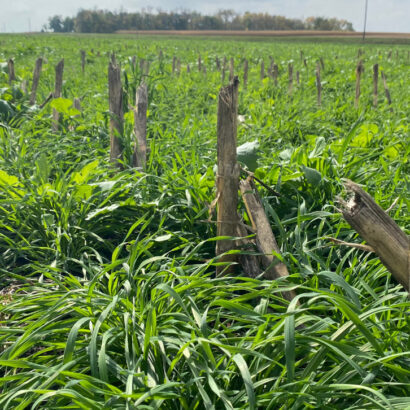(BROOKINGS, SD, Wednesday, July 12, 2023) – In the 1950s, Iowa was the top oat producing state in the U.S., harvesting more than 6 million acres for livestock feed. Now, as livestock operations have concentrated and farms have consolidated, the need for oats as feed has decreased and the law of supply and demand has seen oat production decrease by nearly 99% to only 73,000 acres harvested in Iowa in 2020.
Justin Fruechte, ag product expert at Millborn Seeds, suggests farms still experience the demand for crop diversity.
“Even if livestock are not creating the same demand for crop diversity, the demand still exists. Think about the demands from our soil for diverse nutrient profiles and increased organic matter, the demand from cash crops for nitrogen fixation, the environment’s demand for reduced erosion, or even the way farmers’ cash flows are demanding decreased chemical and fertilizer use. The demand is there, it’s just showing up differently.”
Weatherproofing farms
In late June of 2023, during the peak of a dry stretch, the U.S. saw the worst crop conditions for that time of year since 1988.
“The extreme weather makes you think: What if we focused on creating crop systems that allow our soil to hold water better? What if we had resilient, drought-friendly feed options? What if we shifted our focus to creating crop systems that can handle extreme weather changes?” Fruechte shared.
Reviving the soil with a multicrop approach has more benefits than soil health — it’s an insurance policy against weather unknowns. Better yet, research has shown that diverse farms increase their profits by spending less on fertilizer, fuel, and herbicides in the year after they plant small grains. Profitable systems are worth repeating.
Knowing your land’s roots
The history of crop rotations dates to ancient times because those working the land knew that rotating crops helped control pests and diseases and improved the fertility of their soil. In ancient Rome, they used a two-field system, where they planted half of their land with a cereal crop and the other half was left fallow (and then planted with a legume crop the next year). In the Middle Ages in Europe, the three-field system was introduced, where they planted one-third of their acres to a cereal crop, one-third was left fallow, and the other one-third was planted to a legume crop. In the 18th and 19th centuries, the four-field system was introduced, where the fourth field was used for root crops like potatoes or beets, which allowed for continuous cropping.
Jared Knock, a farmer in east central South Dakota, knows the history of the crop rotations on his land.
“When we bought one of our fields, it had been in a 20+ year corn and soybean rotation. There were low-lying, high saline areas in the headlands that had become essentially useless for growing corn and soybeans. I had to think differently about what we could do to make this land productive.”
Knock worked with Fruechte to develop a plan that fit this land into his farming operation.
“I couldn’t compromise on the profitability of the land, but Justin and I knew we needed to stop disturbing the soil. We developed a seed mix similar to The Stockman, and transitioned the headlands to be a perennial forage source for the cattle. Now, I have a year-round cover, but I still get the feed I need.”

A side-by-side comparison of the headlands in Knock’s field, taken one year apart following harvest.
Adding a personal touch
“I even coordinated the blooms on the alfalfa to match our local school colors. So now, when our daughters ride their bikes down our driveway, they’re surrounded by purple and yellow — go pirates!”
Changing the mindset renews the soil
Fruechte, as a farmer himself, shares the need for diverse crop systems to be practical and profitable.
“We need to rethink our culture of monoculture, while still maintaining simplicity and profitability. No single system will work for every farm, but a simple solution to renew your land exists.”
Fruechte suggests adding a legume for nitrogen fixation, adding a brassica to break up soil compaction, or planting a cereal crop to reduce erosion.
“Start small; you don’t have to change your whole farm overnight. Renew your thinking, revive your land, and repeat your success.”
As land use linchpins, Millborn Seeds is here to help ensure the continued productivity of your land for generations to come.
###
About Millborn Seeds
With over 36 years in the seed industry, the Millborn Seeds team is focused on being trailblazers in resilient land use. Millborn Seeds offers specialized products that fit growers’ needs with more than 1,200 species of seed and are a global grower partner, serving customers in all 50 U.S. states and abroad in several countries. In 2022, Millborn Seeds expanded their headquarters in Brookings, South Dakota, and added a state-of-the-art blending and packaging line. Investments in facilities, technologies, and processes are imperative, as Millborn Seeds leads the way as visionaries in the seed industry.




Discussion
0 Comments